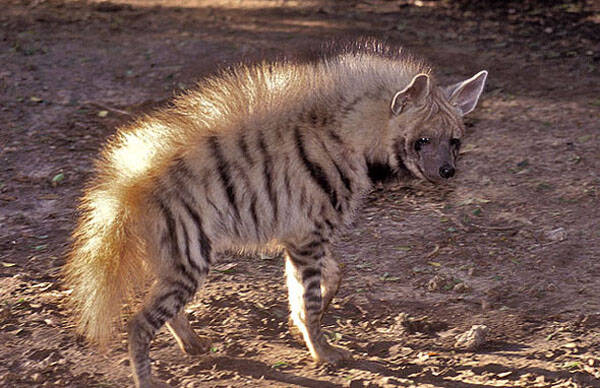Hyaena hyaena
IUCN
LCBasic Information
Scientific classification
- name:Hyaena hyaena
- Scientific Name:Hyaena hyaena,Striped Hyaena, Hyène rayée,Hiena Rayada, Daba'a Moukhattat
- Outline:Carnivora
- Family:Hyaenodon Hyenaidae Hyaenodontinae S.hyena
Vital signs
- length:100-120cm
- Weight:25-55kg
- lifetime:About 12 years
Feature
Except for the face and limbs, it has black stripes and is completely furry.
Distribution and Habitat
Distributed in Afghanistan, Algeria, Armenia, Azerbaijan, Burkina Faso, Cameroon, Chad, Djibouti, Egypt, Ethiopia, Georgia, India, Islamic Republic of Iran, Iraq, Israel, Jordan, Kenya, Lebanon, Libya, Mali, Mauritania, Morocco, Nepal, Niger, Nigeria, Oman, Pakistan, Saudi Arabia, Senegal, Syrian Arab Republic, Tajikistan, United Republic of Tanzania, Tunisia, Turkey, Turkmenistan, Uganda, Uzbekistan, Western Sahara, Yemen.
Striped hyenas live in arid areas, from tropical savannas to deserts, and from sea level to 3,000 meters altitude.
Appearance
The striped hyena has a head-body length of 100-120 cm, a shoulder height of 60-80 cm, a tail length of 25-40 cm, and a weight of 25-55 kg. Like other members of the hyena family, the striped hyena looks like a dog, with a powerful body, the hindquarters are lower than the forequarters, and a stout body. The thick neck, powerful skull and jaws allow the hyena to crush tough dead bones, with an average bite force of 460 kg. The black and white tail is long and thick, and the claws are blunt.
The fur is light gray or beige, with black stripes on the face and limbs, and the back of the neck has a mane that extends from the head to the tail, which will stand up in the event of a conflict, making the hyena look larger and more intimidating. Except for the face and limbs, the whole body is furry. The eyesight is sharp, but the sense of smell and hearing are poor.
Details
Striped hyena (scientific name: Hyaena hyaena) English Striped Hyaena, French Hyène rayée, Spanish Hiena Rayada, Arabic Daba'a Moukhattat, there are 5 subspecies.

Striped hyenas are most often seen alone or in pairs, sometimes in small groups of up to seven. They need a very large range to forage alone and prefer to hunt at night. They often use the same path when moving around their territory, marking the grass stalks with secretions from their anal pouches, leaving obvious signs of the territory owner's presence to warn any intruders. If they happen to meet other hyenas in the area, they will raise their manes in an attempt to intimidate the other, and if a fight breaks out, each striped hyena will try to bite the other's thick neck.
Striped hyenas are omnivorous animals, and because they travel long distances at night, they will eat almost any food they can find. Food includes seeds, leaves, fruits, insects, birds, fish and many species of mammals. A competent hunter, a striped hyena can kill prey as large as a donkey, and can even kill and eat a tortoise with a hard protective shell. It is a fast running and alert animal that can catch hares, foxes and rodents. It is also responsible for clearing the territory of carrion and other scraps abandoned by other carnivores.
Striped hyenas build their dens in rock caves or other caves. The gestation period is about 90 days, and 1-4 pups are born per litter. Hyena cubs open their eyes after seven to eight days, start to grow teeth after 21 days, and can eat meat after 30 days. The lactation period is about one year, during which time the female hyena will take care of the cubs and teach them important foraging skills. Wild striped hyenas live about 12 years.
The biggest threat to striped hyenas is human misunderstanding and superstition about them. They are believed to kill livestock, dig graves and carry off children. Striped hyenas are tracked and trapped until they are hunted, and they also die from traps or poisons set by fur trappers for other species, and accidentally killed by traffic wheels. Once very abundant, striped hyenas have declined severely in most of their range and have become extinct in many places. The species is also threatened by a lack of food and a decline in carrion due to a decline in the populations of other large carnivores, such as wolves, leopards, and tigers.
Striped hyenas are found in several protected areas, including Tiger National Park in India and Serengeti National Park in Tanzania. In 1998, the Hyena Specialist Group published a Conservation Action Plan outlining actions needed to improve the conservation status of all hyena species. Conservation measures were increased throughout the protected areas, and further research was conducted on their behavior, ecology, and biology. It was also recognized that one of the most important, and perhaps the most difficult, challenges is to change people's perceptions of hyenas. Otherwise, it will be difficult to improve the survival status of these fascinating animals.
Listed in the IUCN Red List of Threatened Species in 2014, ver3.1 - Near Threatened (NT).
Protect wild animals and stop eating game.
Maintaining ecological balance is everyone's responsibility!








